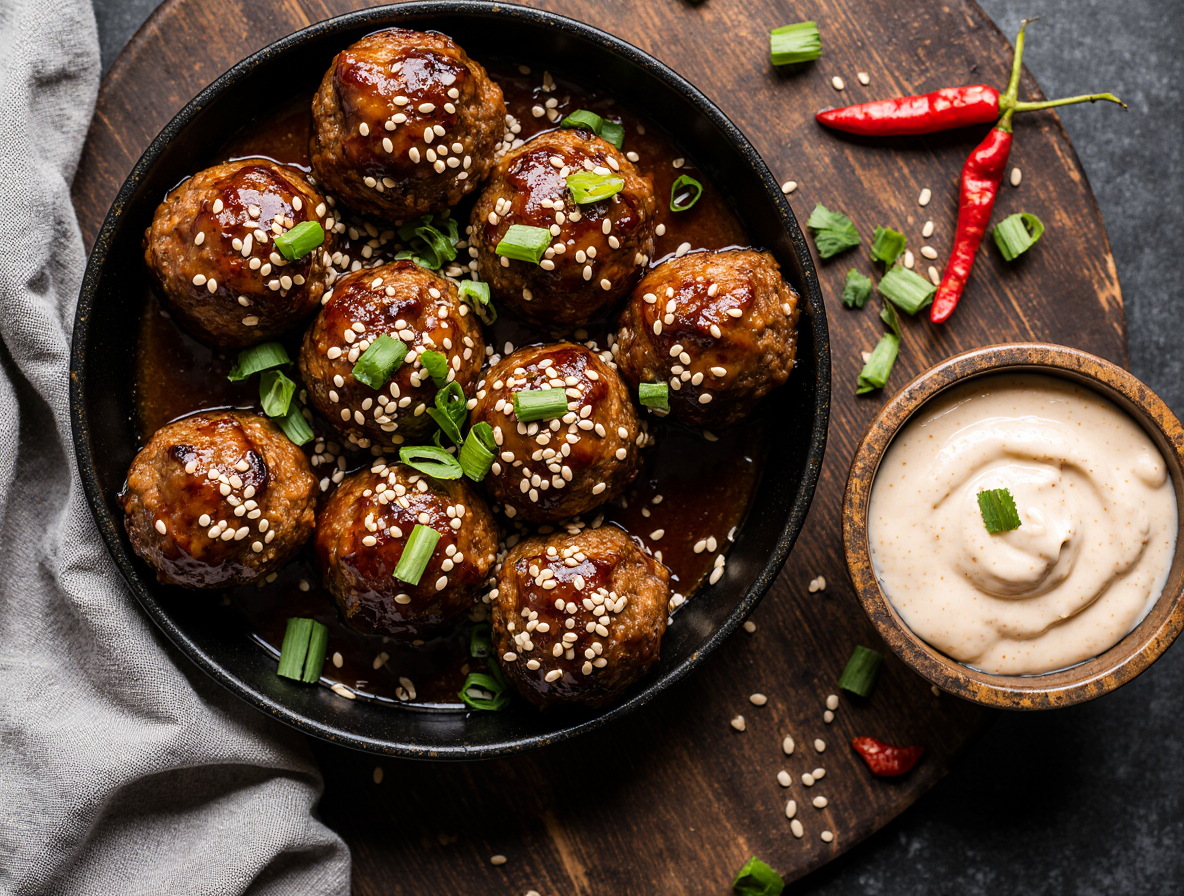The Secret to Perfect Korean BBQ Meatballs Recipe (With Spicy Mayo Dip)
Korean BBQ meatballs recipe brings together a harmonious blend of savory soy sauce, sweet honey, and spicy gochujang that creates a flavor explosion in every bite. I’ve found these juicy, umami-packed meatballs are bound to be a crowd-pleaser at any gathering.
What makes Korean style meatballs truly special is how they take inspiration from traditional Korean barbecue flavors, renowned for their unique combination of tastes and textures. The meatballs are seasoned with soy sauce and sesame oil, which brings out rich umami flavors, while the addition of Panko breadcrumbs ensures they stay perfectly juicy. The best part? They’re quick and easy to make, making them a go-to recipe for any occasion. In this guide, I’ll walk you through our complete Korean BBQ meatballs with spicy mayo dip recipe, from essential ingredients to serving suggestions that will impress your family and friends.
What Makes Korean BBQ Style Meatballs Unique
Unlike their Western counterparts, Korean BBQ style meatballs capture a distinctive culinary essence that makes them stand out in the global meatball family. Their unique characteristics create an unforgettable taste experience that keeps people coming back for more.
Sweet, savory, and spicy flavor balance
The hallmark of Korean BBQ meatballs is their perfectly balanced flavor profile. These meatballs feature a harmonious blend of multiple taste dimensions that dance on your palate. The savory foundation comes from umami-rich soy sauce and sesame oil, which infuse the meat with deep, complex flavors. Furthermore, the sweetness from honey, brown sugar, or maple syrup creates that signature sticky-sweet glaze that balances the other bold elements.
What truly sets these meatballs apart is the addition of gochujang (Korean chili paste). This fermented condiment brings a unique combination of sweet, spicy, and umami notes that can’t be replicated with other ingredients. As one chef notes, “I don’t recommend skipping the gochujang or swapping it for something else—it’s really the star of the flavor show here”. The paste works in harmony with fresh aromatics like garlic, ginger, and scallions to create a profound depth of flavor that’s simultaneously spicy, sweet, and savory.
How they differ from Italian or Swedish meatballs
Traditional Italian meatballs typically feature herbs like oregano and basil, often served with marinara sauce. Swedish meatballs, conversely, incorporate nutmeg and allspice, paired with creamy gravy. In contrast, Korean BBQ meatballs embrace an entirely different flavor profile centered around Asian aromatics.
The traditional Korean version, called Wanja, is often made with a mixture of beef and pork, combined with finely chopped vegetables like onion, tofu, carrots, and scallions. Additionally, the cooking method differs—Korean meatballs are frequently pan-fried after being dredged in flour and egg, creating a distinctively crisp exterior with a juicy interior.
Why they pair perfectly with spicy mayo
The tangy, creamy spicy mayo dip creates a perfect counterpoint to the rich, intensely flavored meatballs. This pairing works because the cool, creamy texture of the mayo softens the bold spiciness of the meatballs while enhancing their savory elements.
The mayo dip typically combines mayonnaise with gochujang or sriracha, sesame oil, and often a squeeze of lime juice for brightness. This combination creates what many describe as “the perfect pairing for a dish that’s both easy to make and packed with flavor”. The cooling effect of the mayo also helps balance the intensity of the gochujang in the meatballs, creating a complete taste experience.
Essential Ingredients and Substitutions
The perfect korean bbq meatballs recipe starts with selecting quality ingredients that capture authentic Korean flavors. Let me break down the essential components that make these meatballs truly special and how you can adapt them to suit different dietary needs.
Choosing the right ground meat
For juicy, flavorful korean style meatballs, the foundation begins with your choice of ground meat. Most recipes recommend using ground beef with 80-85% lean content for optimal tenderness and moisture retention. Ground beef provides a rich, robust flavor that pairs perfectly with Korean seasonings. Nevertheless, you can experiment with ground chicken, pork, or turkey for different flavor profiles and fat content. Each alternative will slightly alter the final texture and taste of your meatballs – pork adds richness, chicken offers lightness, and turkey provides a leaner option.
Key sauces and aromatics
The soul of korean bbq style meatballs lies in their distinctive sauces and aromatics. Gochujang (Korean chili paste) is absolutely essential – as one recipe developer notes, “it’s really the star of the flavor show here.” This fermented paste brings sweet, spicy, and umami notes that can’t be replicated. Paired with low-sodium soy sauce, sesame oil, and occasionally rice vinegar, these ingredients create the signature Korean BBQ profile.
Fresh aromatics play an equally important role. Specifically, minced garlic (typically 2-4 cloves), grated ginger (1-2 tablespoons), and thinly sliced green onions work together to infuse the meat with bright, pungent flavors. For best results, use a microplane for grating ginger and mince garlic finely or use a press for even distribution throughout the mixture.
Breadcrumbs, eggs, and binders
Every great meatball needs reliable binders to maintain shape and juiciness. Consequently, most korean bbq meatballs with spicy mayo dip recipes call for panko breadcrumbs, which keep the texture light yet moist. Alternatively, crushed Ritz crackers (about ½ cup or 12 crackers) make an excellent substitute that adds buttery richness. Eggs act as the crucial glue that holds everything together – typically one egg per pound of meat.
Vegetarian and gluten-free swaps
Plant-based eaters can still enjoy these flavors with smart substitutions. Primarily, Beyond Beef or Impossible ground “beef” makes an excellent vegetarian base. For completely plant-based versions, combine chopped mushrooms (particularly shiitake), tofu, cooked rice, and chopped walnuts for texture. Vegetable options may require additional binders.
For gluten-free adaptations, replace regular panko with almond nut-thins or gluten-free matzo meal crushed in a food processor. Moreover, substitute regular soy sauce with gluten-free tamari and verify your gochujang is certified gluten-free, as not all brands are. These thoughtful swaps ensure everyone can enjoy the bold, complex flavors of Korean BBQ meatballs regardless of dietary restrictions.
Step-by-Step: How to Make Korean BBQ Meatballs with Spicy Mayo Dip
Now that we’ve gathered our ingredients, let’s dive into creating these flavorful korean bbq meatballs with spicy mayo dip. This hands-on process requires attention to detail but rewards you with incredible results.
Mixing and shaping the meatballs
First, place your ground beef in a large bowl and spread the gochujang, soy sauce, and seasonings evenly over the surface before mixing. This technique reduces handling time, keeping the meatballs tender. Next, add minced garlic, grated ginger, green onions, and breadcrumbs. Mix gently with a fork or your hands until just combined – overmixing creates tough meatballs.
Once combined, refrigerate the mixture for about 30 minutes to firm up. Then, with slightly wet hands, form uniform balls approximately 1-2 inches in diameter. This recipe typically yields about 12-24 meatballs depending on your preferred size.
Baking vs. pan-frying methods
Both cooking methods offer distinct advantages. For baking, preheat your oven to 375-425°F and arrange meatballs on a parchment-lined baking sheet. Bake for 15-20 minutes until they reach an internal temperature of 165°F. This hands-off approach is ideal for batch cooking and yields consistent results.
Alternatively, pan-frying creates a deliciously crispy exterior. Heat oil in a skillet over medium heat and cook meatballs for 6-8 minutes, turning occasionally until browned on all sides. Though slightly messier, this method develops a rich crust through the Maillard reaction, intensifying flavor.
Making the Korean spicy mayo recipe
In a small bowl, whisk together:
- Mayonnaise
- Sriracha or gochujang (for authentic korean spicy mayo)
- Soy sauce
- Sesame oil
- Garlic powder
- Optional: lime juice for brightness
Adjust spice levels according to your preference by adding more or less sriracha.
Glazing the meatballs with BBQ sauce
To create the signature glaze, combine soy sauce, honey or apricot preserves, rice vinegar, and gochujang in a small saucepan. Cook over medium heat until slightly thickened, about 5 minutes. Once the meatballs are cooked, brush them generously with this warm glaze. For extra flavor, sprinkle with sesame seeds and sliced green onions before serving.
Serving and Storage Tips
These delicious korean bbq meatballs deserve the perfect presentation and can easily transform from party appetizer to weeknight dinner with the right accompaniments.
What to serve with Korean meatballs
I’ve found that korean style meatballs shine brightest when paired with complementary sides. For a complete meal, serve them over fluffy jasmine rice or rice noodles to soak up all those incredible flavors. Indeed, sticky rice makes an excellent base that balances the bold, spicy notes perfectly.
For a lighter approach, try serving them:
- In lettuce wraps with quick-pickled vegetables
- Alongside stir-fried or steamed broccoli
- With cucumber salad or kimchi for a refreshing contrast
- Over zucchini noodles for a lower-carb option
When hosting, I love offering these as appetizers—simply insert toothpicks and watch them disappear from the platter!
Garnishing and presentation ideas
Elevate your korean bbq meatballs recipe with thoughtful garnishes. Toasted sesame seeds and thinly sliced green onions are traditional finishers that add visual appeal and flavor complexity. Besides these classics, fresh cilantro leaves or thinly sliced radishes can add brightness and color.
For dinner parties, arrange the glazed meatballs in a shallow bowl atop rice, drizzle with extra sauce, and sprinkle with garnishes. Subsequently, serve the korean spicy mayo in a small side dish for dipping or drizzling.
Storing and reheating leftovers
Store leftover meatballs in an airtight container in the refrigerator for up to 4-5 days. Yet, if you’ve combined them with sauce, this may reduce their shelf life slightly.
For reheating, the stovetop method yields the best results. Place meatballs in a skillet over medium heat with a splash of water until heated through (about 5-7 minutes). Alternatively, warm them in a 300°F oven for 10-12 minutes, covered with foil to prevent drying.
Freezing tips for meal prep
Afterwards, once completely cooled, flash-freeze the meatballs on a parchment-lined baking sheet until solid (about 30 minutes). Furthermore, transfer them to freezer bags where they’ll keep for up to 3 months.
Notably, I recommend freezing the sauce separately when possible. Thaw meatballs overnight in the refrigerator before reheating. In reality, you can create convenient meal prep kits by freezing portioned meatballs alongside par-cooked rice and vegetables for quick weeknight dinners.
Conclusion
Korean BBQ meatballs represent a perfect fusion of sweet, savory, and spicy flavors that truly stand apart from traditional Western versions. Throughout this guide, I’ve shared how these flavorful morsels capture the essence of Korean cuisine while remaining accessible for home cooks of all skill levels.
The magic lies primarily in the balance of ingredients – gochujang provides that signature Korean heat, while soy sauce and aromatics create depth and complexity. Additionally, the spicy mayo dip complements these bold flavors, offering a cooling counterpoint that makes each bite even more satisfying.
What makes these meatballs particularly appealing is their versatility. You can serve them as elegant appetizers at your next gathering or transform them into a hearty weeknight dinner alongside rice and vegetables. Furthermore, their make-ahead potential makes them perfect for busy households seeking flavorful meals without daily cooking.
The beauty of this recipe also comes from its adaptability. Whether you prefer baking or pan-frying, beef or plant-based alternatives, the core Korean BBQ flavors shine through regardless of your dietary preferences or time constraints.
Last but certainly not least, these meatballs deliver an impressive flavor-to-effort ratio. Despite their complex taste profile, they remain surprisingly straightforward to prepare. Therefore, I encourage you to gather these ingredients and experience this perfect balance of sweet, savory, and spicy Korean flavors yourself. Your taste buds will undoubtedly thank you!
FAQs
Q1. What makes Korean BBQ meatballs different from other types of meatballs? Korean BBQ meatballs are unique due to their balanced flavor profile of sweet, savory, and spicy elements. They use ingredients like gochujang, soy sauce, and sesame oil, creating a distinct taste that sets them apart from Italian or Swedish meatballs.
Q2. Can I make these meatballs vegetarian or gluten-free? Yes, you can make vegetarian versions using plant-based ground meat alternatives or a mixture of mushrooms, tofu, and chopped walnuts. For gluten-free options, use gluten-free breadcrumbs or almond nut-thins, and ensure you use gluten-free soy sauce and gochujang.
Q3. What’s the best way to cook Korean BBQ meatballs? You can either bake the meatballs in the oven at 375-425°F for 15-20 minutes or pan-fry them for 6-8 minutes. Baking is easier for large batches, while pan-frying creates a crispy exterior.
Q4. How do I make the spicy mayo dip? To make the spicy mayo dip, whisk together mayonnaise, sriracha or gochujang, soy sauce, sesame oil, and garlic powder. You can adjust the spice level to your preference and add a squeeze of lime juice for extra brightness.
Q5. How long can I store leftover Korean BBQ meatballs? Leftover meatballs can be stored in an airtight container in the refrigerator for up to 4-5 days. You can also freeze them for up to 3 months. For best results, thaw frozen meatballs overnight in the refrigerator before reheating.


